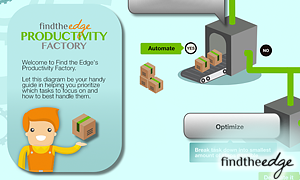 There seems to be no let-up in the huge challenges that organisations have to deal with these days – so it’s no surprise that resilience is increasingly recognised as a critical performance factor for teams and individuals.
There seems to be no let-up in the huge challenges that organisations have to deal with these days – so it’s no surprise that resilience is increasingly recognised as a critical performance factor for teams and individuals.
Building a resilient team is not dependent on selecting a group of hardy individuals – in fact this approach may even weaken the team by decreasing diversity.
Nor is it simply a case of investing in developing everyone’s personal resilience, although of course this can be helpful.
As I mention in my post called “What Exactly Is Resilience and Why Should You Care?” it’s rather a matter of creating the right climate and conditions in the first place, and then ensuring that the team grows in strength by coping successfully with tough challenges.
Building a strong foundation
So let’s start with creating the right climate and conditions. Clearly managers have a primary responsibility here, but it’s important to recognise that everyone has a role to play.
The first point to emphasise is the ‘inoculating' effect that high levels of wellbeing have on a team’s ability to deal with change and other pressures.
For example, improving wellbeing across the group increases collaboration, collective problem solving and information sharing – all of which have a direct impact on the team’s resilience in responding to current and future challenges.
This is an important insight, but it can still be hard to know where to start.
What exactly is meant by ‘wellbeing' in this context? Do you need to call in the reflexologist, build a gym in the basement, or send everyone off to the spa once a week?
Fortunately – while physical health definitely has a role to play – the main answer to wellbeing in teams lies more in people's everyday experience of their work environment.
If this experience is mainly positive for the team as a whole, then morale and wellbeing will be high. If it’s mainly negative, morale will be low and the risk of stress and burn-out will be increased.
‘Chunking' the problem
The key to improvement is assessing the different elements of workplace wellbeing, homing in on priorities for action, and mapping out practical steps that can be taken.
There are various frameworks and tools that you can use for this, including a free Management Standards Indicator tool from the UK Health & Safety Executive (HSE), and various commercial systems that produce individual, team and organisational level reports.
Some of these are derived from models of workplace stress, while others emphasise happiness and draw more on the Positive Psychology movement.
As a manager, it’s useful to consider both angles – reducing stress and increasing happiness.
When you’re looking at managing the risks of stress, the important elements, or ‘chunks' to consider are:
- Work demands
- The influence that people have over what happens and how things are done (control)
- The way change is managed
- The equipment and resources that are available
- Work relationships
- Pay, benefits and other general conditions.
Bear in mind that you need to understand how people perceive these sources of workplace pressure and support – since stress is subjective and kicks in at the point when someone believes that the pressure they’re under may be too much for them to cope with.
This analysis is a good first step, and it’s essential to do what you can to help your team avoid burn-out.
The problem is that so often the most damaging pressures are largely out of your control. The pace of organisational change and a drive to do ‘more with less' are common examples of this.
This is where the happiness angle comes into play.
Happiness is not just about feeling content and free of stress, it includes the satisfaction of being stretched and achieving something challenging and meaningful.
‘Happiness' is really shorthand for experiencing a range of positive emotions – joy, excitement, enthusiasm, inspiration and so on.
This may seem a bit frivolous when we’re talking about team resilience, but just look at this list of what you get when you increase the number of positive emotions people experience over the course of a day:
- Better decision-making
- Improved ‘connectedness' with other people
- Greater concern for others and more helpful behaviour
- A greater sense of ‘we' rather than ‘me' or ‘them and us'
- Increased open-mindedness and curiosity
- Enhanced creativity
- Better management of complexity
- A more positive attitude towards ambiguity or uncertainty
- Better physical health
No wonder psychologists Barbara Fredrickson and Marcial Losada describe these benefits in terms of their ‘broaden-and-build' and resilience-enhancing effects for individuals and teams (American Psychologist, 2005).
So when you find that, in spite of your best efforts, there’s always something draining the team’s ‘wellbeing reservoir', there's still a lot you can do by looking for ways of topping it up with positive experiences.
For example, if people are fed up with the boring, routine nature of their work, you might consider getting them involved in an organisation-wide change project that will stretch their capabilities and help them build good relationships with colleagues from other teams.
More generally, try to notice what lifts their spirits, and think about how you can ensure that happens more often.
Look for opportunities to offer praise and encouragement. Express appreciation and gratitude. Encourage team members to spend time exploring and examining in their discussions, rather than just putting points for or against an argument.
There’s no magic formula, but there are often small actions you can take to make a real difference, once you look at things from this angle.
Growing in strength
As with personal resilience, team resilience is not just about establishing and maintaining a strong foundation.
High levels of wellbeing will put the team in a good position to cope with challenges and setbacks, but won’t necessarily leave it stronger afterwards.
To achieve this you’ll need to ensure that effort is recognised and rewarded, success is correctly attributed and celebrated, and mistakes are understood and learned from.
The result will be increased confidence, sense of purpose, adaptability and ‘social support' (a strong network of supportive relationships) – all of which are core elements of resilience.





